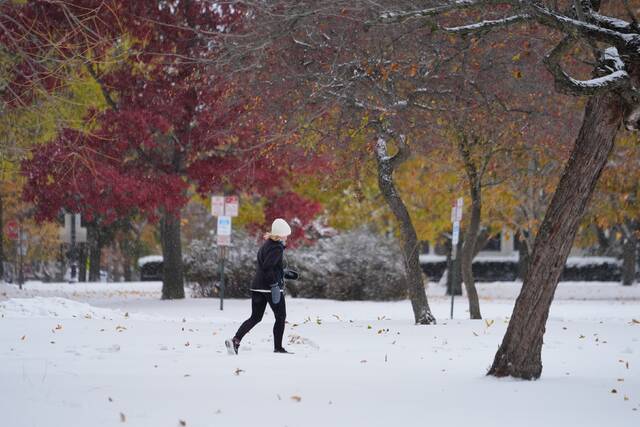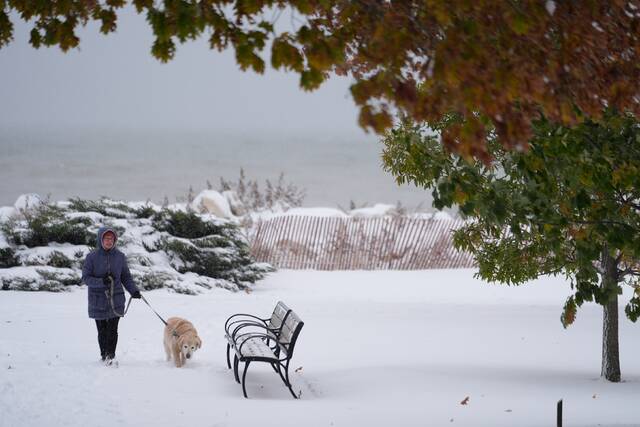Arctic air hits much of the U.S., bringing snow to some areas and very chilly temperatures to Florida
Some of this autumn’s coldest weather yet is bearing down on the United States, enveloping the eastern two-thirds of the country with Arctic air on Monday and affecting millions of people.
National Weather Service forecasters said the weather could bring record low temperatures in the U.S. Southeast, including all of Florida, where temperatures in parts of the state were near 80 degrees just a day ago.
The cold air brought gusty wind and red flag warnings in the Great Plains on Monday, and forecasters said the Great Lakes and Appalachian Mountain regions could see 4 inches to 8 inches of snow.
Around Lake Erie, forecasters warned of possible lake-effect snow, where copious amounts can fall in relatively narrow bands, drastically increasing snowfall near the water while leaving other nearby areas untouched.
Cold weather warnings were issued for Ohio, West Virginia and Kentucky, with freezing temperatures predicted for a large swath farther south, from Texas and Oklahoma to Alabama and Georgia.
Chill could cause falling iguanas in Florida
In Florida, forecasters said wind chills could dip to the 30s. Whenever it gets that cold in the Sunshine State, many look to the trees: Iguanas, an invasive reptile species, have previously gone into a sort of suspended animation and fallen to the ground when temperatures dip below 40 degrees. They usually wake up with the sun’s warmth — although it is unclear whether any of the reptiles will tumble from the treetops this time.
Freeze warnings cover much of the Southeast as the coldest air of the season sends temperatures plummeting as far south as Florida on Tuesday, with record lows expected. Meteorologist @StephanieAbrams has what you need to know ⬇️ pic.twitter.com/HmNr6rJ80s
— The Weather Channel (@weatherchannel) November 10, 2025
Across the south, many local governments opened heated shelters for residents struggling to cope with the cold.
Those resources are invaluable in St. Louis, Missouri, where some people are still waiting for essential repairs on their houses after a powerful EF3 tornado ripped through the region in May. City officials announced Monday that emergency shelters would be open for homeless people as well as those who still dealing with the aftermath.
Hazardous conditions for road travel
In Tennessee, temperatures dropped to 30 into Sunday morning, and areas with higher elevation in the eastern part of the state reported that 3 inches of new snow had fallen by 9 a.m., causing some school closures. Snow-slickened roads led to a crash involving multiple vehicles and about an hourlong shutdown on westbound Interstate 40 in Putnam County, east of Nashville, the county sheriff’s office announced.
Further north, as temperatures dropped across the nation’s midsection, meteorologists warned of hazardous travel conditions through winter weather advisories for Michigan, Indiana and Wisconsin. Snow fell Sunday in Michigan’s Upper Peninsula, where meteorologists warned of low visibility with up to a foot of snow by Monday.
In Indiana, weather experts predicted up to 11 inches of snow and “slippery surfaces” for road travel. Up to 6 inches of snow were predicted in parts of Wisconsin.
“Patchy blowing snow” and wind chills hovering near freezing were expected in portions of Minnesota, Nebraska and South Dakota. Some areas got measurable fluff a day earlier, including 4 inches of snow in southwest Minnesota and more than 5 inches in northern Iowa.
Gardeners, the growing season has now ended
Weather experts issued special guidance for gardeners in the Midwest and northeast, saying the freeze warning means the growing season has ended.
“Take steps now to protect tender plants from the cold,” warned meteorologists in Arkansas.
Growers of peppers, eggplants, squash and leafy greens in north Florida were harvesting as much as they could on Monday and preparing irrigation lines to make sure they don’t freeze up and crack.
South Florida, where most of the state’s winter fruits and vegetables are grown, was expected to be spared any freeze based on the current forecast. Citrus, Florida’s best-known crop, also was expected to dodge a hit since citrus trees typically sustain damage only when the thermometer drops below 28 degrees.
“The freezing temperatures are likely to miss our major growing regions for fruits and vegetables,” said Christina Morton, a spokeswoman for the Florida Fruit & Vegetable Association.
The cold snap may have a sweet side: As long as temperatures stay above freezing, some Florida crops such as strawberries and blueberries could benefit because cool weather enhances their taste and quality, Morton said.
Remove the ads from your TribLIVE reading experience but still support the journalists who create the content with TribLIVE Ad-Free.



